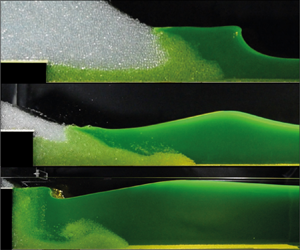Crossref Citations
This article has been cited by the following publications. This list is generated based on data provided by
Crossref.
Sarlin, Wladimir
Morize, Cyprien
Sauret, Alban
and
Gondret, Philippe
2021.
Collapse dynamics of dry granular columns: From free-fall to quasistatic flow.
Physical Review E,
Vol. 104,
Issue. 6,
Nguyen, Nhu H. T.
2022.
Collapse of partially and fully submerged granular column generating impulse waves: An empirical law of maximum wave amplitude based on coupled multiphase fluid–particle modeling results.
Physics of Fluids,
Vol. 34,
Issue. 1,
Kriaa, Quentin
Viroulet, Sylvain
and
Lacaze, Laurent
2022.
Modeling of impulse waves generated by a viscous collapse in water.
Physical Review Fluids,
Vol. 7,
Issue. 5,
Sarlin, Wladimir
Morize, Cyprien
Sauret, Alban
and
Gondret, Philippe
2022.
From granular collapses to shallow water waves: A predictive model for tsunami generation.
Physical Review Fluids,
Vol. 7,
Issue. 9,
Lipiejko, Natalia
Whittaker, Colin N.
Lane, Emily M.
White, James D. L.
and
Power, William L.
2022.
Experimental Modeling of Tsunamis Generated by Pyroclastic Density Currents: The Effects of Particle Size Distribution on Wave Generation.
Journal of Geophysical Research: Solid Earth,
Vol. 127,
Issue. 11,
Heller, Valentin
and
Ruffini, Gioele
2023.
A critical review about generic subaerial landslide-tsunami experiments and options for a needed step change.
Earth-Science Reviews,
Vol. 242,
Issue. ,
p.
104459.
Poulain, P
Friant, A Le
Mangeney, A
Viroulet, S
Fernandez-Nieto, E
Castro Diaz, M
Peruzzetto, M
Grandjean, G
Bouchut, F
Pedreros, R
and
Komorowski, J-C
2023.
Performance and limits of a shallow-water model for landslide-generated tsunamis: from laboratory experiments to simulations of flank collapses at Montagne Pelée (Martinique).
Geophysical Journal International,
Vol. 233,
Issue. 2,
p.
796.
Nemati, Fatemeh
Leonard, Lucinda
Thomson, Richard
Lintern, Gwyn
and
Kouhi, Soroush
2023.
Numerical modeling of a potential landslide-generated tsunami in the southern Strait of Georgia.
Natural Hazards,
Vol. 117,
Issue. 2,
p.
2029.
Mao, Yunfei
and
Guan, Mingfu
2023.
Mesh-free simulation of height and energy transfer of landslide-induced tsunami waves.
Ocean Engineering,
Vol. 284,
Issue. ,
p.
115219.
Li, Pengfeng
Jing, Haixiao
and
Li, Guodong
2024.
Generation and prediction of water waves induced by rigid piston-like landslide.
Natural Hazards,
Vol. 120,
Issue. 3,
p.
2683.
Bougouin, Alexis
Viroulet, Sylvain
Lacaze, Laurent
Roche, Olivier
and
Paris, Raphaël
2024.
Dry granular collapse into a liquid: Role of viscous dissipation on granular flow regimes and associated waves.
Physical Review Fluids,
Vol. 9,
Issue. 12,
Sarlin, Wladimir
Morize, Cyprien
Sauret, Alban
and
Gondret, Philippe
2024.
Effondrement de châteaux de sable dans l’eau : des tsunamis de laboratoire.
Reflets de la physique,
p.
24.
Darvenne, Abigaël
Viroulet, Sylvain
and
Lacaze, Laurent
2024.
Physical Model of Landslide‐Generated Impulse Waves: Experimental Investigation of the Wave‐Granular Flow Coupling.
Journal of Geophysical Research: Oceans,
Vol. 129,
Issue. 9,
Jin, Xin
Qin, Yi-yi
Tao, Yuan
and
Lin, Peng-zhi
2024.
Numerical modeling of transient nonlinear water waves generated by horizontally moving bottom disturbances.
Physics of Fluids,
Vol. 36,
Issue. 11,
Mao, Yunfei
and
Guan, Mingfu
2024.
Computational investigation of the relationship between landslide-related conditions and resultant dam overtopping waves.
Engineering Applications of Computational Fluid Mechanics,
Vol. 18,
Issue. 1,
Yuan, Hao
Xia, Chunhua
Zhou, Xidong
Sun, Qian
Hu, Ruichang
Diao, Wei
and
Mao, Yunfei
2025.
Landslide-induced impacts on downstream vessels based on an accurate and robust smoothed particle hydrodynamics framework.
Physics of Fluids,
Vol. 37,
Issue. 1,
Hu, Zhengyu
and
Li, Yuzhu Pearl
2025.
Full-scale tsunami-induced scour around a circular pile with three-dimensional seepage.
Coastal Engineering,
Vol. 197,
Issue. ,
p.
104676.
Wen, Yonghao
Wei, Yingjie
Wang, Cong
Wang, Fuchen
and
Wang, Yulin
2025.
Experimental study on the collapse of partially immersed axisymmetric granular columns.
Physics of Fluids,
Vol. 37,
Issue. 1,

 ${Fr}_f$ based on the ratio of the velocity of the advancing granular front and the velocity of linear gravity waves in shallow water: transient bores for large
${Fr}_f$ based on the ratio of the velocity of the advancing granular front and the velocity of linear gravity waves in shallow water: transient bores for large  ${Fr}_f$, solitary waves for intermediate values of
${Fr}_f$, solitary waves for intermediate values of  ${Fr}_f$, and nonlinear transition waves at small
${Fr}_f$, and nonlinear transition waves at small  ${Fr}_f$. The wave amplitude relative to the water depth increases with
${Fr}_f$. The wave amplitude relative to the water depth increases with  ${Fr}_f$ in the three regimes but with different nonlinear scalings, and the relative wavelength is an increasing or decreasing function of
${Fr}_f$ in the three regimes but with different nonlinear scalings, and the relative wavelength is an increasing or decreasing function of  ${Fr}_f$ depending on the wave regime. Two of these wave regimes are rationalized by considering that the advancing granular front acts as a vertical piston pushing the water, while the last one is found to be a transition from shallow- to deep-water conditions. The present modelling contributes to a better understanding of the rich hydrodynamics of the generated waves, with coastal risk assessment as practical applications.
${Fr}_f$ depending on the wave regime. Two of these wave regimes are rationalized by considering that the advancing granular front acts as a vertical piston pushing the water, while the last one is found to be a transition from shallow- to deep-water conditions. The present modelling contributes to a better understanding of the rich hydrodynamics of the generated waves, with coastal risk assessment as practical applications.


